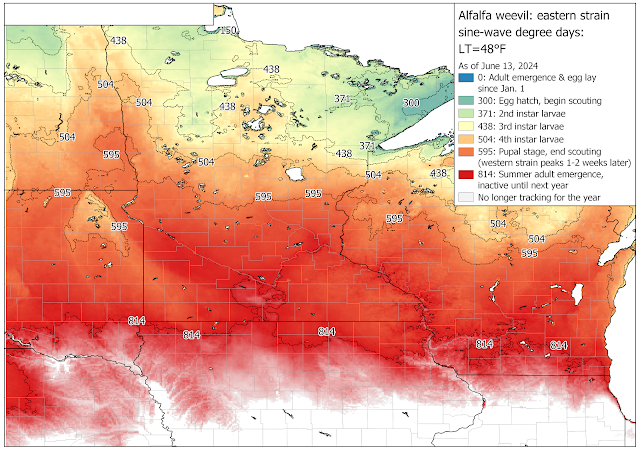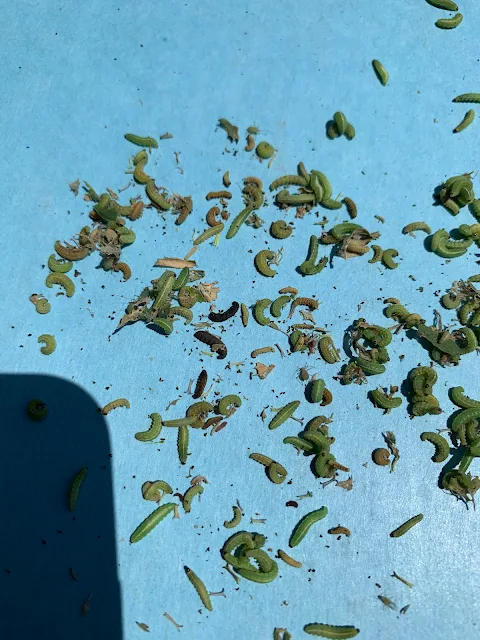Anthony Hanson (hans4022@umn.edu), Extension IPM Regional Educator - Field Crops
Since the previous mid-May Minnesota Crop News post detailing tools available for 2024 alfalfa weevil management, multiple calls have come in showing just how difficult of a season this has been alfalfa growers dealing with this pest. The end of weevil season should be in sight for most growers possibly this week, though scouting should continue through June. Forecasting the timing of pest development (i.e., phenology) is a key tool for an integrated pest management (IPM) plan for alfalfa weevil.
Temperature-based forecasts of alfalfa weevil development are based on degree-days for the eastern strain. As of June 13, 2024, at least according to the forecast model, larvae should cease feeding and develop into pupae across central Minnesota at 595 Fahrenheit alfalfa weevil degree-days (Fig. 1).
 |
| Figure 1. Forecast alfalfa weevil development as of June 13, 2024 based on observed daily high and low temperature. Click on the image for higher resolution. Scouting can end once larvae have developed into pupae that are no longer feeding. Updated maps available at: https://vegedge.umn.edu/alfalfa-weevil |
After scouting this week in Stearns and Pope counties in unsprayed fields that had not yet had their first cutting, it's wasn't uncommon to find fields that had obvious leaf feeding from alfalfa weevil, but no larvae to be found when they had been present the previous week. In those cases where fields were near treatment thresholds, growers benefited by not needing to spend money on insecticide treatments this year. Insecticides were also very much warranted in many fields across the state that did have larger weevil populations, so this underscores the importance of both monitoring pest population sizes and keeping timing in mind as well.
Using the six-day temperature forecast, it looks like the eastern strain should be done feeding in the Red River Valley area and north of Otter Tail, Wadena, and Pine counties by mid-week next week (Fig. 2).
 |
| Figure 2. Forecast alfalfa weevil development for up to June 19, 2024 based on observed daily high and low temperature and the 6-day temperature forecast. Click on the image for higher resolution. Updated maps available at: https://vegedge.umn.edu/alfalfa-weevil |
The caveat with any forecast model is that they are not meant to be perfect, and you will often find exceptions to overall predictions each year, especially as you look across an entire state or region. In this case, the potential presence of the western strain of alfalfa weevil could throw off predictions in these maps. As mentioned in the previous article, this strain tends to have delayed development of about one to two weeks behind the eastern strain. Its range in Minnesota is unknown, but was present along the Minnesota and Dakota borders in its westward move in 1998. This means that while alfalfa weevil populations should start to be on the decline, farmers should still be scouting their alfalfa through the end of June in case they do find threshold levels of feeding larvae.
On a welcome note, the warm wet spring may also be helping with weevil management in some fields this year. These conditions are ideal for a fungal disease of alfalfa weevil caused by Zoophthora phytonomi (Fig. 3). These diseases along with parasitoid wasps that attack alfalfa weevil are examples of biological control, another important tool in the IPM toolbox. The success of pathogens is much more based on ideal environmental conditions, but if insecticides aren't needed this year in a given field, this may help maintain parasitoid wasp populations that can help keep weevil populations under threshold levels in future years.
 |
| Figure 3. Alfalfa weevil collected near Stillwater. Some larvae in the center of the picture appear black, which may be due to the pathogen Zoophthora phytonomi. Photo: Glen Borgerding. |
For more information on alfalfa insect management and how to determine if insecticide application is warranted for other pests such as potato leafhopper, visit: https://extension.umn.edu/forage-pest-management/alfalfa-insects-what-look-and-how-scout.
Comments
Post a Comment